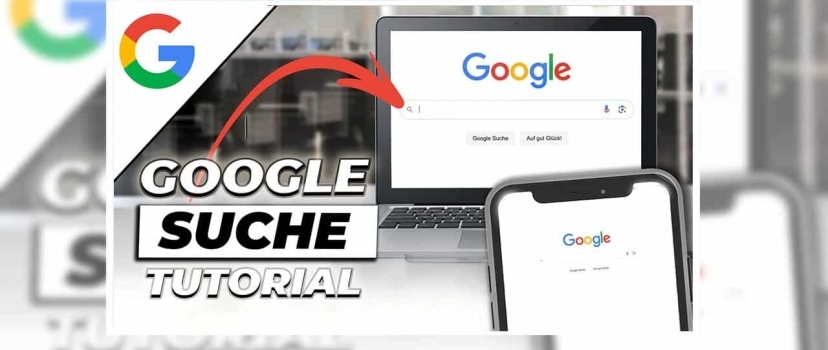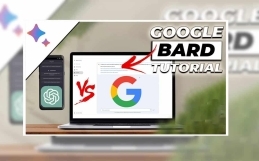Google Search
Here's how it works and how you can use it for yourself as an online retailer
In our ultimate Google search tutorial, we explain how search works on Google. We explain how a search results page is built up, how the search algorithm works, but also what you have to consider technically in Google SEO to get the best possible ranking with your page. Also, it’s about what method you should use if you want to see quick results. At the end, we’ll give you 5 tips for more accurate search results. All that in this in-depth episode.
Google Search - An Introduction
So thatevery reader is first on the same level, a short introduction to Google Search. The fact that the Chrome mobile and desktop browser have a combined market share of almost 60%, and that the browser has automatic Google search built into the URL bar, means that we automatically use Google as our search engine instead of Bing, DuckDuckGo or others. So it can be said that Google has established itself as a search engine. This may not be relevant for the average consumer, but for the entrepreneur, for example, it is not. For online retailers, however, this is a very, very important insight. After all, what is the point of taking place somewhere where your target group does not take place. So the fact that Google Search has up to 8.5 billion searches a day is an important point for this video. Because it only makes sense to advertise where there are many and the right people. For example, it may be more lucrative for the online retailer of lifestyle products to rely on TikTok as an advertising platform, but the jewelry retailer may fare better with Google. But before we go too much into advertising, a few side notes about Google Search itself. This has in fact existed under this name since 1997. Since then, the search engine has been growing steadily. Both in terms of supported language variants and the number of indexed pages. It is not possible to put a precise figure on how high the latter is. But one fact that proves that Google as a search engine has also arrived in the mainstream in this country in 2004 at the latest is the inclusion of the verb “googlen” in the Duden dictionary. I think it should be clear by now that Google is no longer just a text search engine. Besides this, there are extensions like Google Shopping, Google Images, Google News, Google Books Google Maps, etc. To get a further overview of them, we recommend our Google SEO Playlist,
But how exactly does Google search work?
Google Search demonstrates
To first understand what we are talking about, let’s just Google the keyword “Google”, then “car dealer Munich” and then “create Oxid eShop”. Now you may wonder what this is all about. Yes, there are three completely different terms, but they show one thing: The Google search or the search results or also called SERPs, can always look different. If a topic is currently relevant, a news section will be displayed. Followed by a Twitter carousel. Exactly the same should be found if we currently enter “Bundesliga” at the end of the season. And lo and behold, here too the headline section is at the top and the Twitter carousel is close behind. If, on the other hand, you are looking for a location-related place such as a workshop, a restaurant or similar, then a Google Maps snippet will be displayed almost first. By the way, a snippet is called an entire Google result. So the rank 1 would be a snippet, the rank 2 would be a snippet and so on.
Why the SERPs always look different
With our Oxid eShop search the whole thing looks different again. This is a commercially contested keyword, which is why the very first thing we see here is Google Ads. You can recognize this by the “Sponsored” marking. So, with these Google ads, you pay to be displayed at the top for a certain keyword or even several keywords. Directly below is a normal snippet, which by the way is counted as organic rank 1. That is, when you talk about ranking, that is, on which place you are, then logically the ads are not counted to me, because they are inorganic. But we will come to that later. Important for now is just – There is purchased reach and there is organic reach. What is special here now is that for this search term, that is “create Oxid eShop” you can see a video carousel. Why is that? Because Google noticed that there are relevant videos on this topic. These are always preferred. That’s why it makes double sense to focus on video marketing in 2023. This means that we can only have a limited influence on how the SERPs look in the end. If we create a lot of high-quality content on a certain topic, we can try to make our mark on the SERPs. But you can never be sure that it will work.
This is what a snippet in Google search consists of
But let’s pick apart the classic snippets within the search results page. In addition, it must be said that this is only conditionally a classic snippet, as we are dealing with a so-called rich snippet. If the term doesn’t mean anything to you, take another look at our detailed sequence. In short, these rating stars make this snippet a rich snippet. But besides the stars, this one, started at the top, first consists of the name of the page. Next to it we have the stored favicon and the exact URL this link leads to. What is used here as link text is the so-called Meta Title. The one below is the Meta Description. So this is how a classic snippet would be structured. In addition to this, we can also search for images, videos, shopping results, books, etc. in addition to the classic text search. We get info about how many results exist for this search query and we can specify our search query again by using the search filter. The result will be different for each search type. For example, you can search for colors or usage rights in the image search, but filter for a specific language in the text search. By the way, as a little gimmick, Google adds a Google Doodle every now and then. That is the company logo on the top right, is then globally adjusted to fit a particular event. For example. The 2018 Christmas Google Doodle from.
The types of Google search
But in order to have a complete overview of what types of Google search there are, let’s go through each one. We have just covered Google text search. Next, let’s take a look at Google Shopping. If we enter a shopping term, like “men’s shoes” we notice two things. On the one hand, a Google Shopping carousel is played out as the first snippet, but on the other hand, the arrangement of the special searches also changes. Now the Google Images section is no longer arranged first, but “Shopping”.
This means that this arrangement is also based on what the most relevant results are. Google Shopping, by the way, is a price comparison portal that can be managed via the Google Merchant Center and placed through Google AdWords. If we enter a more visual search term, such as “The Scream”, i.e. the painting, the first search type is “pictures”. Here, images related to a search term are displayed that are located on websites indexed by Google. You can find out more in our linked detailed episode. Under the URL: blog.google you can search for blogs on a specific topic. If you enter a location-specific search term, Google Maps will be displayed as the first result. This is navigation and map system. That means you can browse for locations on the map or by direct search. You can display routes and so on. A detailed sequence already exists for this as well.
Other species at a glance
Furthermore, there is Google Books for a targeted book search, Google Scholar for the search for scientific sources, Google Videos for the search for videos from indexed websites, YouTube or other video platforms and Google News for current topics. To search for patents, Google Patents is available, to search for flights, there is also a flight search since 2011, with play.google.com the own app store can be called and last but not least Google Trends to pick up current trend topics. So you can see that a lot has happened since 1997. But now that we know what Google is, how the SERPs are structured and which search types there are, we should now delve a little deeper into the matter and understand exactly how Google Search works technically.
How Google Search Works
The foundation of Google is the index. You can imagine this as a gigantic library. This means that the entire World Wide Web is searched by a bot and then stored and archived in a search index. But this bot doesn’t just blindly go ahead and index everything it finds. Certain criteria apply in order for you to be approved for indexing. But we’ll go over the topic of indexing in more detail in a moment. It is important to note here that your page must be in the Google index in order to be displayed in the SERPs in the first place. By the way, you can check this by typing “site:eureurl” into the Google search. So for example. Site:ebakery.com. Then you will see that some pages have already been indexed.
Google SEO Basics
This means that through your search query using a certain keyword, the Google index is searched and displayed in a certain ranking by means of gripping algorithms. Here, many factors play a role in which place the algorithms rank you, including the relevance, the content strength and number, your location, how often the keyword appears on the page, the history of your page and many others. It is also always crucial how the search query is made. Whether as bullet points or questions. Or whether there is a certain topicality included. So if you have e.g. asks about the trends in 2023. Then the history of the page is less relevant, but the timeliness of the content. This means that if you want to build up good rankings, you should follow Google’s guidelines and fulfill as many important points as possible that you can influence. This is exactly where one speaks of SEO, i.e. the search engine optimization of one’s own site.
Let’s now go through in detail which points belong to this.
How Google Search Works
Google Search proceeds in such a way that it analyzes the individual words of the search query individually, but also in context, and then categorizes them. One category would be topicality. This means that the algorithm checks whether the search query is related to a current topic or not. That’s exactly what we’ve just been talking about. If it is a current topic, pages with a current reference are preferred. If it is not, the history dominates, i.e. the page that exists longer. On the other hand, not only the content of the search query is analyzed, but also the matching of the exact keyword phrase. So the keyword is for example “Create Oxid eShop”, then the algorithm looks for where and how often this exact phrase occurs. Here are for example the H1 headline, the URL, the metadata more weighty than a paragraph within a landing page. But if the keyword occurs too often, the post may be considered spam by Google. This is the reason why Google is not a static, but a dynamic system. Google’s claim is to provide users with the best possible results. In other words, to present the perfect answer, so to speak, to the search query.
This is why Google updates
That’s why the algorithms are also becoming more complex every year. In the past, for example. one practice is keyword bashing, i.e. placing a keyword in a text quite often, partly without meaning. At some point, this was punished, so they resorted to new methods. For example, at times it was common to obtain backlinks by camouflaging your links in forums with white writing on a white background, which meant that they remained undetected and were not deleted by the forum operator.
This is what you need to consider
So you always have to put yourself in the perspective of the site visitor. Do you find the content helpful yourself? Do these answer the core question?
But besides content aspects, text length also counts, as well as technical aspects. Is the page responsive?
So it displays correctly on both mobile and desktop devices? How fast does the page load? Is there a layout shift, that is, reloading elements or moving elements that would negatively impact the user experience. Most of it is handled with the so-called Core Web Vitals. The estimated quality of a page also includes the backlink strength. So if several external sites write about you and you link, this strengthens the trust of your site.
These are all the factors that you can influence. But there are also non-influenceable criteria. This includes location, search history, individual search settings and the like. Thus, the SERPs for the same keyword in two different places, can turn out differently. You can try this out with the help of a VPN. Another example.
Free SEO Tools
Searches e.g. someone searches for Hertha against Union and then enters “Berlin” as a search term, the search results might relate more to soccer rather than the city itself. So this is what is meant by taking the search history into account. It goes without saying that this individualization is all the more drastic when you are logged in with the Google account.
That’s why you should either check your rankings in the incognito window of your browser or use tools like our free SEO tools. Here the completely objective rankings are displayed without individual coloring.
Page not indexed - What to do
But to explain all the factors that could be relevant for a ranking, it takes more than one video. That’s why you’re better off with the Google SEO Playlist if you want to gain more in-depth knowledge. Or you can rely on eBakery as your Google SEO partner. Our page is also linked again in the video description. Click on it and make an appointment with our experts. That’s why we’ll conclude by addressing specific questions. The first one is: What can I do if my page has not been indexed and therefore does not show up in Google search?
If your site meets Google’s criteria but still doesn’t show up in search, you can submit a sitemap in Google Search Console. The sitemap gives Google a hint that these pages exist and should be crawled. If they were crawled and found to be indexable, this will also be displayed in the Search Console. If you have created new pages, you can also submit an indexing request for them individually. How do I rank high for a generic keyword very, very quickly?
The Google Ads
Fast and SEO don’t really go together. Unfortunately, this is a marketing strategy for which it takes a lot of patience. At least when it comes to popular keywords. But if you want to go the fast way and budget is available, you can run Google Ads. The pay-per-click model has been in existence since 2002 and enables advertisers to buy visibility. However, this can be achieved not only in the SERPs as a classic text ad, but also through video advertising on YouTube, as a Google Shopping campaign and more. The billing model differs, for example. to the classic Facebook Ads model. Facebook paid for reach. So whether someone clicked on it or not was not relevant for that. With Google advertising, however, you only pay for the click. If no one clicks on it, you don’t pay anything.
Requirements to be able to advertise on Google are a Google account, a Google Ads account and a website.
Here, too, we as a Google Ads agency can assist you either in an advisory or executive capacity.
5 tips for a more efficient Google search
But before we get to our big conclusion, here are 5 tips for a targeted Google search.
Tip 1: If you want to search for an exact phrase, put it in quotation marks. Then the procedure is not as described in this video before, but it is only searched for exactly this word or phrase in the same order and based on that the ranking is formed.
Tip #2: If you can’t remember the full movie title or the name of a complicated dish or a very long song title, you can use the asterisk symbol as a placeholder. Let’s make a comparison and enter “Harry Stein” without the special character. Well, books are displayed, but not what we are looking for. If we now enter “Harry* Stone*”, “Harry Potter and the Philosopher’s Stone” appears on the first page. So it does make a difference.
Search for specific file types
Tip #3: If you want to exclude certain terms from the search, you can do so as follows: You enter your main keyword normally. So for example. Apple. What we are now shown first is the iPhone. But we don’t want that. So we leave Apple and put “-iPhone” after it with a space. And as you can see all iPhone results are excluded. By the way, to exclude completely offensive results you can use the syntax “safesearch” at the end.
You can exclude complete URLs with -URL. So “Apple -apple.com”, already the website will not appear in the SERPs. Tip #4: Find documents. Do you want e.g. find a PDF file, then type after your keyword: “filetype: pdf”.
So for example. “Indian cooking recipes filetype: pdf”. And lo and behold, the SERPs already show you that there is a PDF document behind the link. And our final tip #5: It doesn’t matter whether you write the search terms in lower or upper case, it has no influence on the search.
Our conclusion
I hope you are now fully informed about what is behind Google Search. That you can search not only for classic websites, but also specifically for Maps entries, for images, for videos, for Google Shopping results, etc. However, you now also know that it takes a sophisticated strategy to be displayed on the first page for a keyword. Therefore, sometimes you should rather focus on long-tail keywords, because the competition has too big a head start. So before you burn money and invest in marketing in the wrong place, get better advice in advance.
Google SEO Agency
However, if there are any questions about this, leave them for us in the comments. We will do our best to answer you there. However, should you wish to be advised otherwise, then we are available to you as an eCommerce, but explicitly also as a Google SEO agency.
Do you have questions or need an individual offer? Do not hesitate to contact us.
- 0/5
- 0 ratings
| Very bad! | Bad | Hmmm | Oke | Good! |
|---|---|---|---|---|
| 0% | 0% | 0% | 0% | 0% |
Haben Sie Fragen oder brauchen ein individuelles Angebot? Zögern Sie nicht, uns zu kontaktieren.



















